Tired of losing money trading supply and demand?
This might just be the post that turns your trading around.
Supply and demand traders lose money for many reasons: drawing zones incorrectly, entering using weak signals, trading the low probability zones, etc.
But there’s another reason so many lose:
By following the wrong rules for trading the zones.
Like most strategies, supply and demand has rules on how the strategy should be traded. For example, look for zones with a strong move away as they tend to be strong is a rule you may have heard before.
The problem with many of these rules (including that one) is they’re actually wrong. They don’t really make sense with how the market works. So when you follow them you end up with losing trades, not because you did anything wrong, but because the rules themselves were wrong in the first place.
To solve this, I’ve come up with my own 5 rules.
These 5 rules will allow you to trade the zones the right way. They cover everything from which zones to trade, how to determine strong zones from weak ones, which direction to trade the zones in… basically everything you need to know to trade the zones properly I’ve put into these rules.
Let’s get started…
A Strong Move Away Doesn’t Mean A Zone Is Strong
Have you ever wondered why seemingly strong supply and demand zones often fail to cause reversals?
When I first started trading S & D, I wondered this myself. My guru at the time said zones with strong moves away were the best to trade, yet they kept falling. Again and again, these (supposedly) strong zones failed, and I couldn’t understand why.
As I learned more about trading, specifically how order flow works, I realized the guru’s had got it wrong.
The strength didn’t depend on the move away as they said, it was determined by the move seen before the zone formed.
To explain why we need to talk about how a zone forms.
All supply and demand zones form from the banks. The banks cause the zone to form from buying and selling. Most of the time it’s from taking profits, but many also form from them placing trades. Whichever it is isn’t important. They both form in the same way under the same process.
To place their trades or take profits, the banks need orders.
In other words, they need other traders (people like you and me) to be buying or selling at the time they want to buy or sell. The bigger the trades they want to place or the more profit they want to take, the more people they need to be buying or selling.
Simple enough, right?
So what this means is the strength of a supply or demand zone depends on how big the bank’s trades were or the amount of profit they took off to cause a zone to form.
If the banks placed big trades, they don’t want price to break through the point where they placed them (the supply or demand zone), as it could cause them to lose money. That then means the zone is strong because they don’t want price to break through.
But here’s where it gets deeper…
The size of the trades the banks can place or the amount of profit they can take depends on the orders coming in, right? The number of people buying or selling. The more people who are selling, let’s say, the bigger the size of the buy trades the banks can place.
So really, the strength of a zone is determined by the movement seen before the zone formed.
If the movement seen prior caused lots of people to sell, for example – such as in the case of a strong downtrend – that must mean the demand zone is strong, because the banks would have had lots of sell orders to place big buy trades, due to the downtrend.
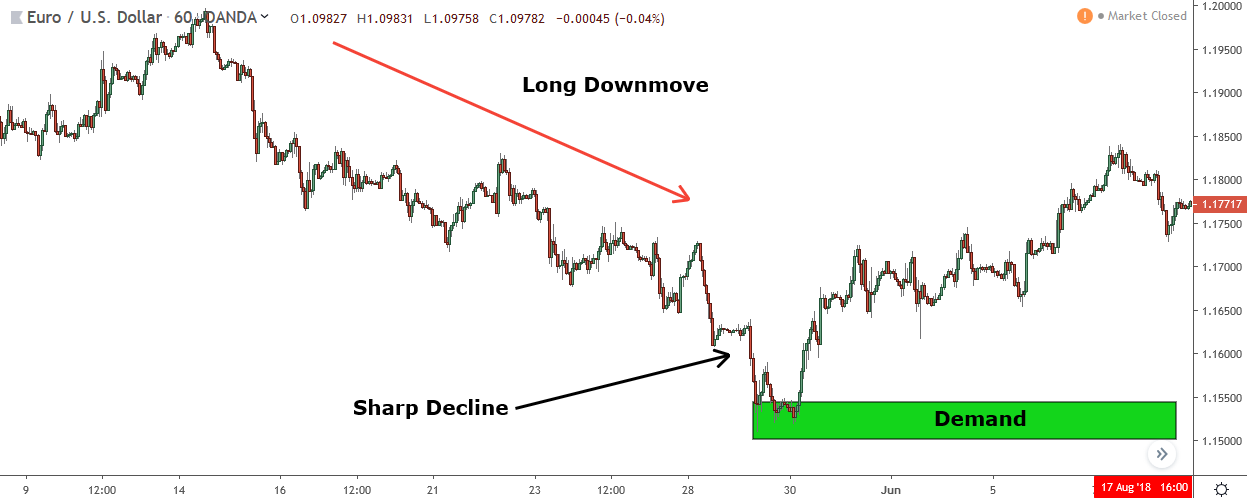
Notice that before this demand zone formed, the market was in a strong downtrend, and a very sharp decline had just taken place.
What do you think most traders are doing at this point?
Buying or selling?
Selling, right? They’re selling 1. because the overall trend is down (everyone gets told to trade with the trend, remember) and 2. as they’ve just seen huge decline take place – sharp rises and declines always cause people to trade in the same direction.
So right now, the banks have a huge number of sell orders to either take profits or place trades with.
If they decide to buy, and a demand zone forms, that zone will be extremely strong. Because they will have been able to place lots of trades or take lots of profits off, due to the huge number of orders coming in from people selling.
If I move it forward…
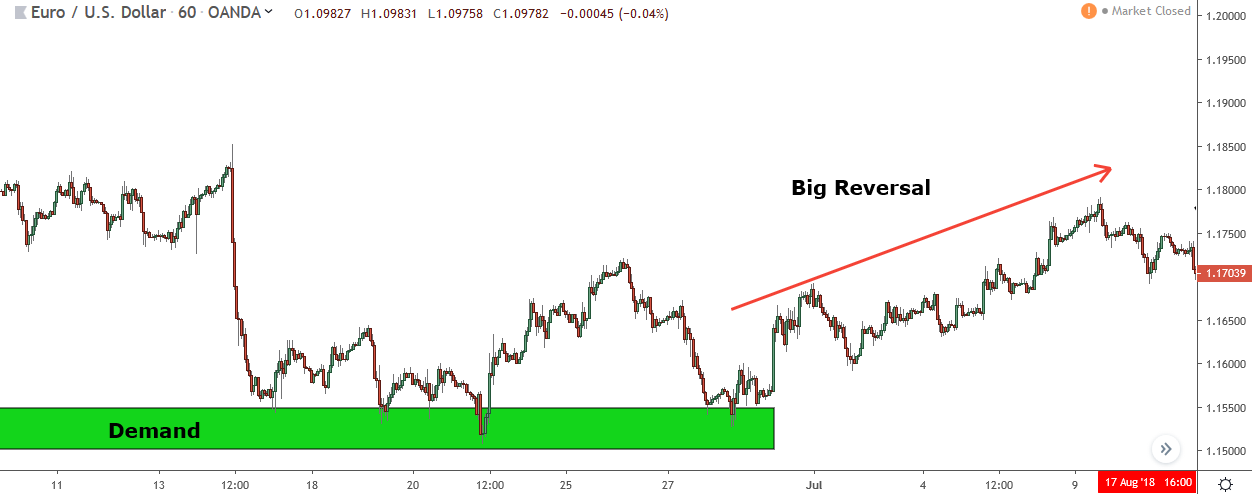
A demand zone forms.
What happens when price returns? It reverses, and a huge reversal gets underway, resulting in price eventually rising over 1000 pips.
Does it make sense how this works then?
It’s not the move away that tells you how strong a zone is – though it is a good way to find the zones – it’s the move seen before the zone formed.
If a zone forms after a long down move (demand) or long up-move (supply), it’s very strong, because the banks have had a lot of orders to place their trades or take profits. Same for sharp moves. Most people buy or sell if they see a sharp rise or decline, meaning the banks have a lot of orders to use, making the zone strong.
I know this method of gauging the numbers of orders coming in isn’t exactly scientific and takes a bit of understanding, but it is an effective way of gauging how strong a zone is.
I’ll have a guide in the future that details this method in more detail.
Only Trade The First Touch
Supply and demand has a lot in common with support and resistance. Believe or not, I actually thought S + D was just a cheap S & R knockoff when it first became popular – seems silly now considering it’s my main strategy. For the most part, being similar is a good thing.
But I’ve noticed something…
I’ve noticed that a bunch of traders think because supply and demand is so similar to support and resistance, the zones cause multiple reversals, as S & R levels do.
While this makes sense, it’s not true.
Supply and demand zones are a ONE time use. Not 2 times, not 3 times, just once. After price returns to a zone and reverses, it’s done with. The probability it’ll cause another reversal is extremely low.
The reason zones only work once, as opposed to the multiple times like we see with S & R, is again because they form from the banks buying and selling.
Price returns to supply and demand zones because the banks have either a. not got all their trades placed or b. not taken all their profits off.
But here’s the important point to remember…
Most of the time, the banks get their trades placed/profits taken in 2 lots. For example, they’ll place one set of buy trades, which is the first lot, then another set as the second lot due to not having enough orders available.
The only exception to this is when they’re causing a trend reversal, in which case they’ll place them in 4 possibly 5 lots, causing multiple swing highs or lows to form at similar prices – something else I’ve talked about before on this site.
Now, how do supply and demand zones form again?
Oh yeh: from two lots.
The banks first set of trades/profit-taking is what creates the zone – this is lot 1 – and their second batch is what causes price to reverse when it returns, which is lot 2.
So the reason why zones don’t work multiple times is that the banks have no reason to make price come back after the first touch.
They can get most of their trades placed creating the zone, and causing price to return and then reverse. After that, they don’t have any left, making it unlikely a second touch will cause a reversal.
Always Trade With The Trend… On The Time Frame You Trade Off
I know, I know, you’ve heard it a thousand times. But bear with me because I’ve added this rule for a reason…
Most traders think trade with the trend means the overall trend i.e the trend on daily or weekly time-frames. That’s what all the books say, and many gurus agree. But unless you trade on those time-frames, trading with the overall trend is a big mistake. In fact, it could even be the reason you’re losing money.
The problem with trading with the overall trend rather than the trend on the time-frame you trade-off is instead of trading with the trend you trade against it.
Sound confusing?
Let me explain…
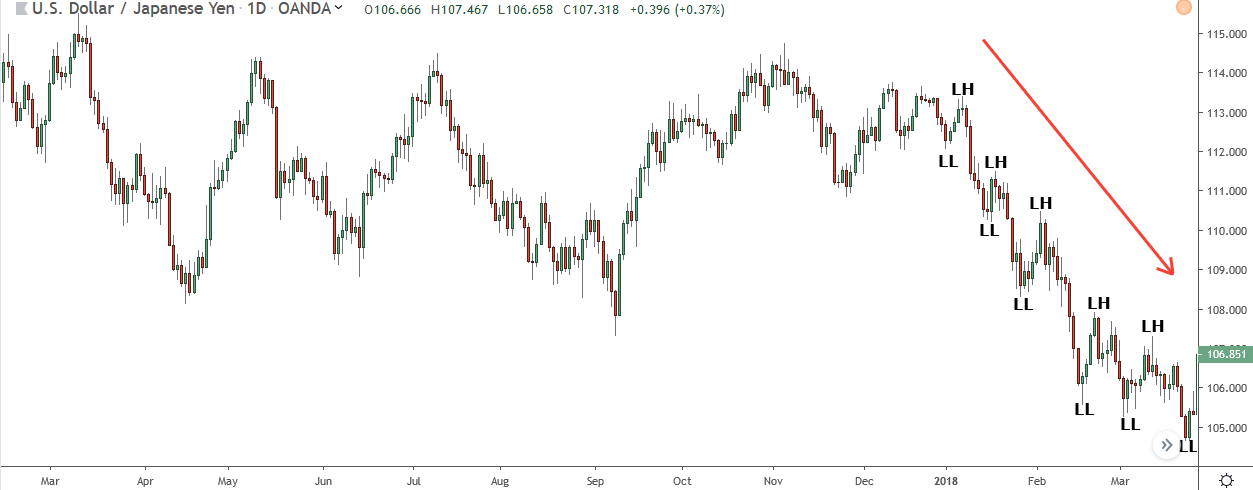
Imagine you trade on the 1-hour chart but get your trend from the daily.
At the moment, the daily trend is down. It’s been falling for quite a while now, and the market has just recently made a new lower low after a previously making a lower high.
So now you switch back to the 1 hour and begin looking for short trades from supply zones.
But here’s the problem…
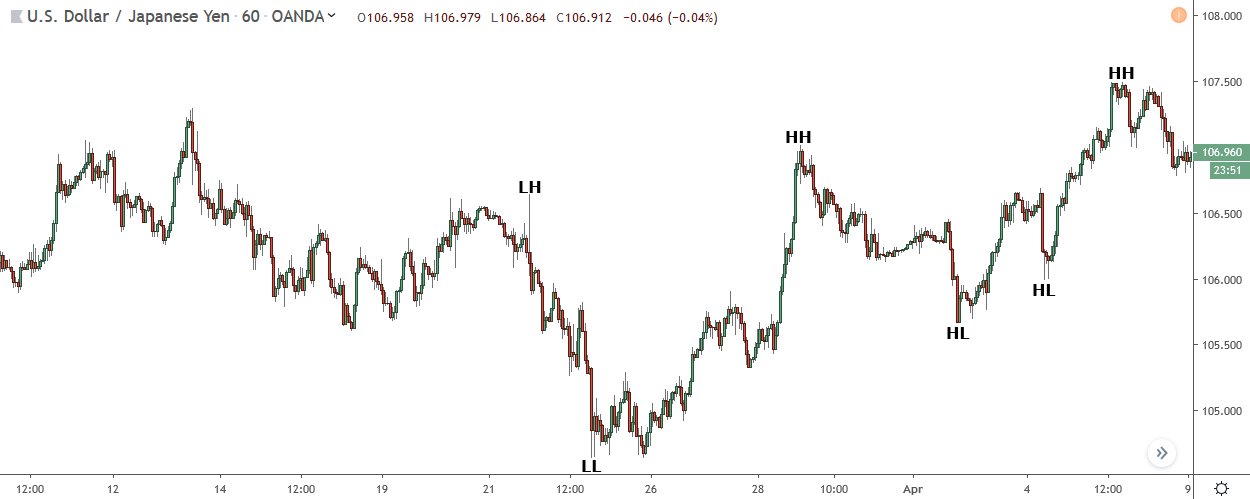
On the 1 hour, the trend is up.
It’s just made a higher low after previously making a higher low, indicating the trend has changed and price is now likely to rise.
What this means is you’re really trading counter-trend. Even though the trend on the daily is down on the 1 hour it’s up. So while you are trading with the trend, at the same time you’re trading against it, because the 1-hour trend is up not down.
Now watch what happens to the supply zones…
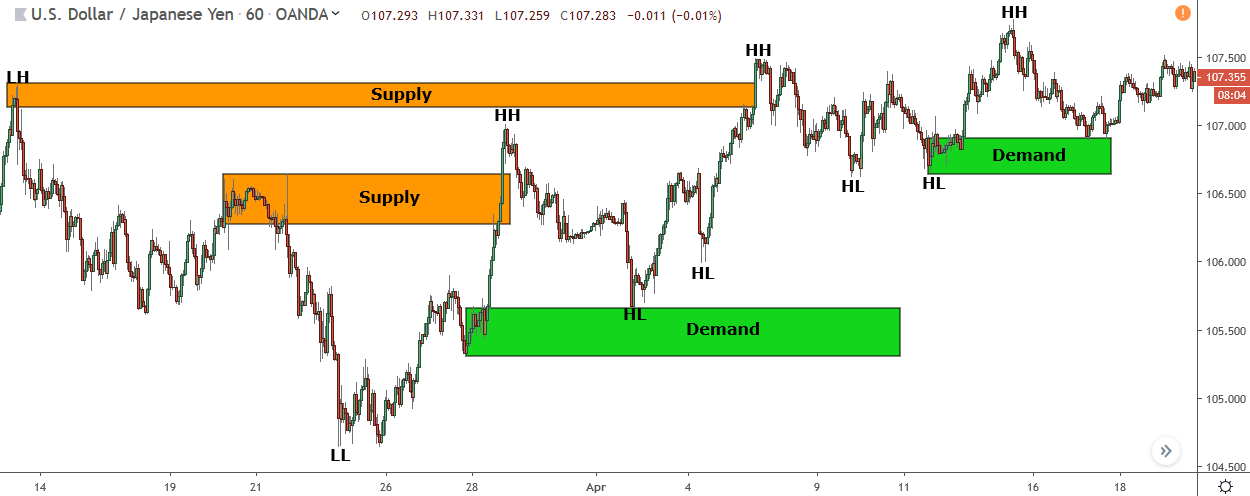
Apart from one, they all fail.
None of the zones result in successful reversals – major ones at least. On the other hand, all the demand zones that formed after reversal did work, and caused quite a few reversals you could have used to make money from.
This is the big problem with trading with the overall trend.
The trend on the time-frame you trade-off and the overall trend are two different things. The overall trend only matters for that time-frame (daily or weekly). It’s too long to be relevant for the time-frame you trade-off, in this case, the 1 hour.
In the example, you were technically trading with the trend. However, at the same time, you were trading against the trend on the time frame you trade-off, which is much more relevant because of the shorter timescale.
The best way to ensure you trade with the time-frame you trade-off – or the current trend as I call it – is to always trade in the direction of the most recent higher high or lower low.
The newest lower low/higher high is the most up to date indication of what the trend on that time-frame is. So by following it, you keep yourself on the right side of the market. It’s still important to keep to the overall trend in mind, for significant points and whatnot, but the current trend is the one to always trade with.
Stay Away From Rally Base Rally – Drop Base Drop Zones
Rally-base-rally/drop-base-drop zones have a good reputation with most supply and demand traders.
Back in the day, I used to trade these zones A LOT. In fact, for a time, they were all I traded. I didn’t even bother with the rally-base-drop/drop-base-rally zones, I just stuck with the rally-base-rally/drop-base-drop zones I thought there were that good.
But then I went back…
I went back and looked at my losses over 7 months. What did I find? Most of my losses that hadn’t come from personal mistakes (like moving the stop too early) had come from trading rally-base-rally/drop-base-drop zones.
Now you could say I was just trading them wrong… and that may be true.
However, I went back and did some backtests on RBR – DBR zones and even accounting for mistakes found they really don’t work as well as people claim. Sometimes they work, but most of them fail, usually as a result of price blasting straight through.
I guess the question now is, why is this?
Why don’t rally-base-rally/drop-base-drop zones work as well as rally-base-drop/drop-base-rally zones?
I think there are a few reasons…
The main one, however, comes back to what I said at the beginning, about how the strength of a zone is determined.
The strength of a supply and demand zone is based on the preceding movement. For example, a demand zone that forms after a sharp decline is likely to be strong because the banks had lots of sell orders available, due to the sharp decline.
But this also works the other way…
If a zone forms after a move in the same direction e.g a demand zone after a sharp rise, that zone isn’t very strong because the banks haven’t got enough sell orders to place big buy trades.
Now, how do all rally-base-rally/ drop-base-drop zones form?
After a move in the same direction!
They all form after price has already moved in the same direction; a rise in the case of rally-base-rally zones, and a decline for drop-base-rally zones.
This makes them much weaker than rally-base-drop/drop-base-rally zones – which form from a move in the opposite direction – as the banks don’t have as many orders to buy or sell with.
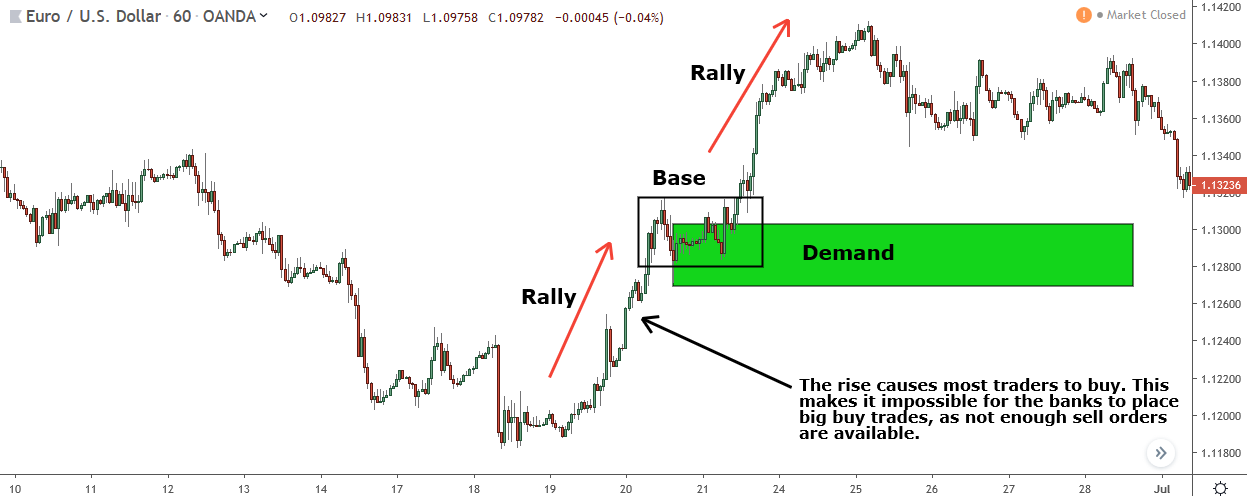
Take a look at this rally-base-rally zone I found on Eur/Usd.
According to most guru’s, this zone has a good chance of success. It’s formed from a nice base, it has a strong move away, and is in the direction of the current trend.
But look at where it formed…
The zone formed AFTER a strong rise, which meant most traders were buying; some as a result of closing short trades placed during the decline, many because they thought it was the beginning of a reversal.
With most traders buying, the banks don’t have many sell orders to use.
This means they can only place a small number of buy trades or take a limited amount of profit off. This then makes the resulting demand zone weak, because the banks will only want price to reverse from a zone if they’ve done something significant, like place a big bunch of trades.
And what happens when price returns?
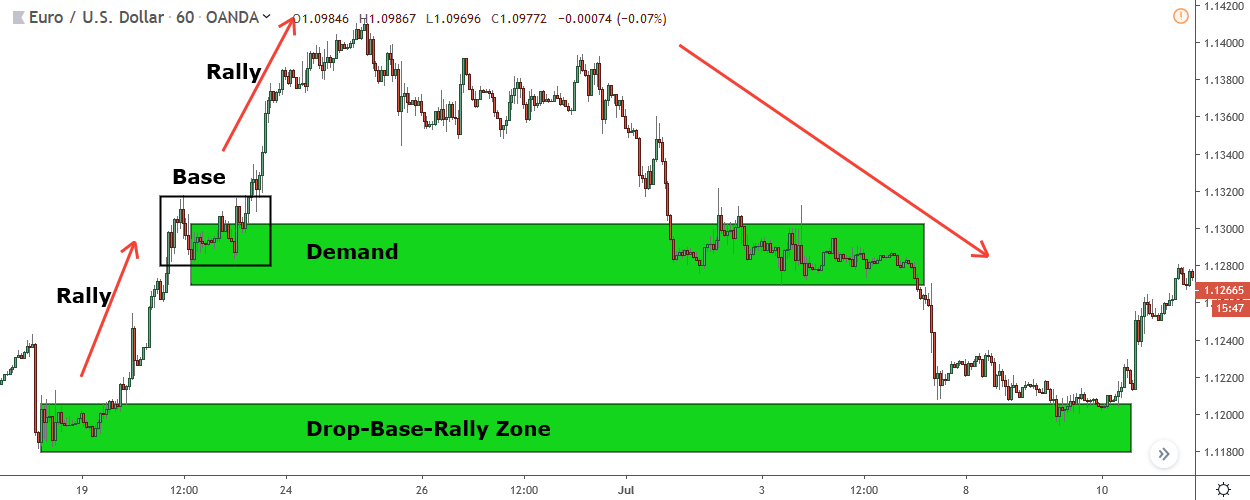
Price stalls for a while then breaks through. Where does it reverse? Surprise, surprise… the drop-base-rally demand zone that formed at the beginning of the rise.
So does this make sense, about why the zones don’t work that well?
It’s because they form after a move in the same direction rather than the opposite.
Rally-base-drop/drop-base-rally zones all form after a move in the opposite direction, which gives the banks lots of orders to buy or sell with. Rally-base-rally/drop-base-drop zones, on the other hand, all form after a move in the same direction, which gives the banks only a few orders to buy or sell with.
Don’t Trade Old Zones
There are some big mistakes to avoid trading supply and demand.
Trading zones more than once is one of the big ones, like I said earlier. But another is something many S + D traders don’t really know about or even class as a mistake…
Trading old zones.
I’ve seen lots of guru’s say or imply that old supply and demand zones have the same probability of causing a reversal as new zones. According to them, old zones function and perform exactly the same as new zones; there’s no difference between them other than their age.
When you look at the charts, it’s obvious why they think this.
Old zones (seemingly) cause reversals all the time. Go back weeks, months, or even years, and I can guarantee you’ll find old zones that have recently caused price to reverse.
But is it really the zones causing the reversal?
The answer…
No.
It looks like it is because price has reversed from the same point, but it’s not the zone itself causing the reversal, it’s something else. What that is depends on the zone and what was happening at the time. But it’s definitely not the zone, it just seems like it is.
If you think about how zones form and why they work the way they do, it’s obvious why old zones don’t cause reversals.
The banks cause a supply or demand zone to form by either placing trades or taking profits. They then cause price to come back to a zone because they haven’t been able to get all of their trades placed or take all of their profits off, as I’ve already said.
My question is, why would they wait months or years to do this?
If they’ve placed a bunch of trades because they think price will rise, why would they wait a few months to get the rest placed? By that time, price could be miles away from where they bought, and their reason for buying in the first place might not even exist anymore.
This is why I don’t buy that old zones cause price to reverse.
It doesn’t make sense for the banks to wait weeks, months, or years for price to come back to a zone. If they want to get their remaining trades placed/profits taken, they’ll make price come back to a zone quickly. They won’t wait weeks and weeks, they’ll do it soon.
So, how do you know whether a zone is too old to be traded?
Well, really, there is no sure-fire way. However, I have come up with a few rules (or guidelines is probably the best way to put it) of how many days, weeks, or months it takes for a zone to become old, relative to the time-frame it formed on.
Here’s what they are:
1 min/5 min/15 min – 1 day.
30 min/1 hour/4 hour – 20 days
Daily – 3 months
Keep in mind these are just guidelines. They’re not cold hard rules that can’t be broken.
If you see a zone form within two or three points of what I’ve explained e.g a zone 23 days old instead of 20 the zone is still valid for trading even though it is technically old. It’s impossible to get these things exact, so you have to allow a bit of leeway with the time.
Another point is if a zone forms within a higher time-frame zone e.g a 1-hour zone forms inside a daily zone, the 1-hour zone falls under the daily/weekly rule. It doesn’t come under the 1-hour rule because it’s part of the daily zone; the banks have caused it to form from placing trades with the daily time-frame in mind.
Summary
Test these rules out for a while, see if they make a difference. They won’t turn you into a successful trader overnight – nothing will – but they will allow to start trading the zones in write way, rather than the wrong way spread by most gurus and experts.

Again great article that pushed me to next level. Great work, keept it 🙂
Liam I have one question. Do you using inside bars in trading? If yes can you write something about this PA signal please?
Sure do, Lucky. I use them mainly for scaling in, though, not for trading reversals. I’ll get a few articles about them out in the next couple of months, so you can see how I use them.
so. according to the method. likes. if I find the s/d zone at the big round number by using the method above. can I go down to the lower timeframe to find the signal to entry?
You can, but make sure you look for a significant engulf to get an entry. The normal size engulfs on the lower time-frames often aren’t enough to cause a reversal from a higher time-frame zone. So you have to look for the real big ones, as they have decent chance of causing a reversal.
Hi. get one question, according to the rules above. can I use it to find the s/d zone on lower timeframe. such as15m chart, or 5m chart. to locate the zone, just use the method in “the ultimate guide to find supply demand zone”(I mean find the zone with sharp rise or decline). or there’s another way to locate the zone on lower timeframe.
Thanks
Sorry for the late reply Marvin, I forgot all about your comment.
Sure, the method outlined in the guide applies to all time-frames and currencies, not just the 1 hour and daily. Whatever time-frame you’re on it works the same, just follow the rules and find the zones.
Hope this helps.
Hi, can you more talk about the insider bar trading,
i have test this for a while, but, you know, when the price is in the trend, there are lots of the retracement, so, how to trade with the insider bar, because, i don’t know when the retracemnt going to happen or not.
Thx
I’ll get something out about inside bars soon, Marvin. Someone else mentioned it a couple weeks back, but I’ve been trying to finish off a few S + D posts, so I haven’t had chance to do it.
I’ll try to get a post about it out within the next month or so.
Thank you for this great post !
Like many traders, I discovered S/D strategy with Sam Seiden and I would like to have your opinion on 2 Odds Enhancers he is using :
– How many time price did spend at the level ?
– The risk-reward ratio between a demand zone and a supply zone
Currently I made a setup with a score by counting the odds enhancers but after reading your blog, I think there is some adjustement to do.
Thanks
Thanks Guysmo, glad you found it useful!
Here’s my response to your question…
I wouldn’t put too much emphasis on those odds enhancers, to be honest. They’re not things that make a big difference to whether the trade works or not.
Like, time spent at zone doesn’t really matter, because the banks sometimes take a while to get their trades placed, due to the orders (or lack thereof) they have available. Risk reward ratio, though important, isn’t something I’d concentrate on, as it varies after you enter a trade. It’s all well and good to say “I’m going to target the next supply zone”, but in reality, the market doesn’t work that way; different events change the risk-reward as price moves to the opposing zone, which nullifies its original importance.
If I were you, I’d concentrate on the 3 enhancers below…
1. Where the zone formed – zones that form after long rises and declines have a much better chance of causing reversals.
2. The age of the zone – old zones don’t cause reversals, so concentrate on finding recent zones.
3. How many touches a zone has – only trade zones with zero touches.
4. The type of zone – RBD/DBR zones work much better than RBR/DBD zones, though they do occasionally cause reversals.
Stick to trading zones based on these enhancers, Guysmo. Forget the enhancers Sam says; time spent away from zone, what the move away looks like etc… just focus on these, and you should get into some much more profitable trades
Hope this helps,
Liam.
A gold answer.
I found your YT channel yesterday, so many content to watch !
Thanks again.
whats the YT channel name?
very nice
What time line would you use for Weekly and Monthly zones until they are considered old and not valid?
Thanks
Neil
Probably around 2 months Neil, give or take a few days. I don’t really pay attention to the weekly and monthly charts, so I don’t know for sure what the best time is. However, I’ve just had a little look, and 60 days seems to be a good time, so long as you allow for a few days variance – so if a zone is 63 days over, it’s still considered valid for trading. I’ll have another look this weekend anyway, just in case some adjustments need to be made, but that should serve you well for the time being. Stay safe, have a good weekend.
Hi. Liam
for the supply demand zone trading. do you have the scientific method to calculate. how far the price should move, in order to forms the strong s/d zone
thx
I don’t unfortunately, Marvin.
I’ve tried coming up with different methods like no of pips away, what kind of move away typically indicates a strong zone, how the volume looks, but nothing concrete has come of it so far. It’s just something you have to be able to weigh up on your own, I think. I wish there was a simple, mechanical way to know whether a zone is strong or not – would make my job A LOT easier, that’s for sure – but unfortunately, I haven’t been able to find anything.
I’ll keep searching anyhow. I’ll try to get a post out in the future that explains step by step on how to determine the strength of a zone, that should make it a little easier for you and others.
Stay safe,
can i use supply and demand zone in the stocks markets beside forex ?
Yes, Jacob! Supply and demand works in stocks the same as in forex. Just find the zones, wait for price to enter, then watch for a signal. Just be aware of the important news announcements for each stock, so you don’t get caught off guard – news will push price through the zones from time to time.
Hope this helps,
Thank you very much This helps alot 🙂
Can you elaborate on only trading in the direction of the last LL or HH a bit more? Can you provide a chart example of what you are talking about? Thanks in advance.
Noted: I’ll try to get something out about soon, E.
Thanks for the comment.
I’ll try to add a bit more context in an update E. But basically, what I mean is trade in the direction of the trend on the TF you take trades off – not higher TF. If you use two TF for trading – a higher TF for trend direction, a lower TF other for entry – the lower TF will show a trend change quicker than the higher TF… because it’s lower. But if you only get the trend from the higher TF, you won’t realize this… you’ll think the trend is still the same. So, you’ll end up with losing trades as really, you now trading counter-trend rather than with the trend. Make sense?
Like I said, I’ll try to elaborate more in an update or future post – it’s not the easiest thing to explain, so could probably use a bit more context.
Hope this helps, anyhow.